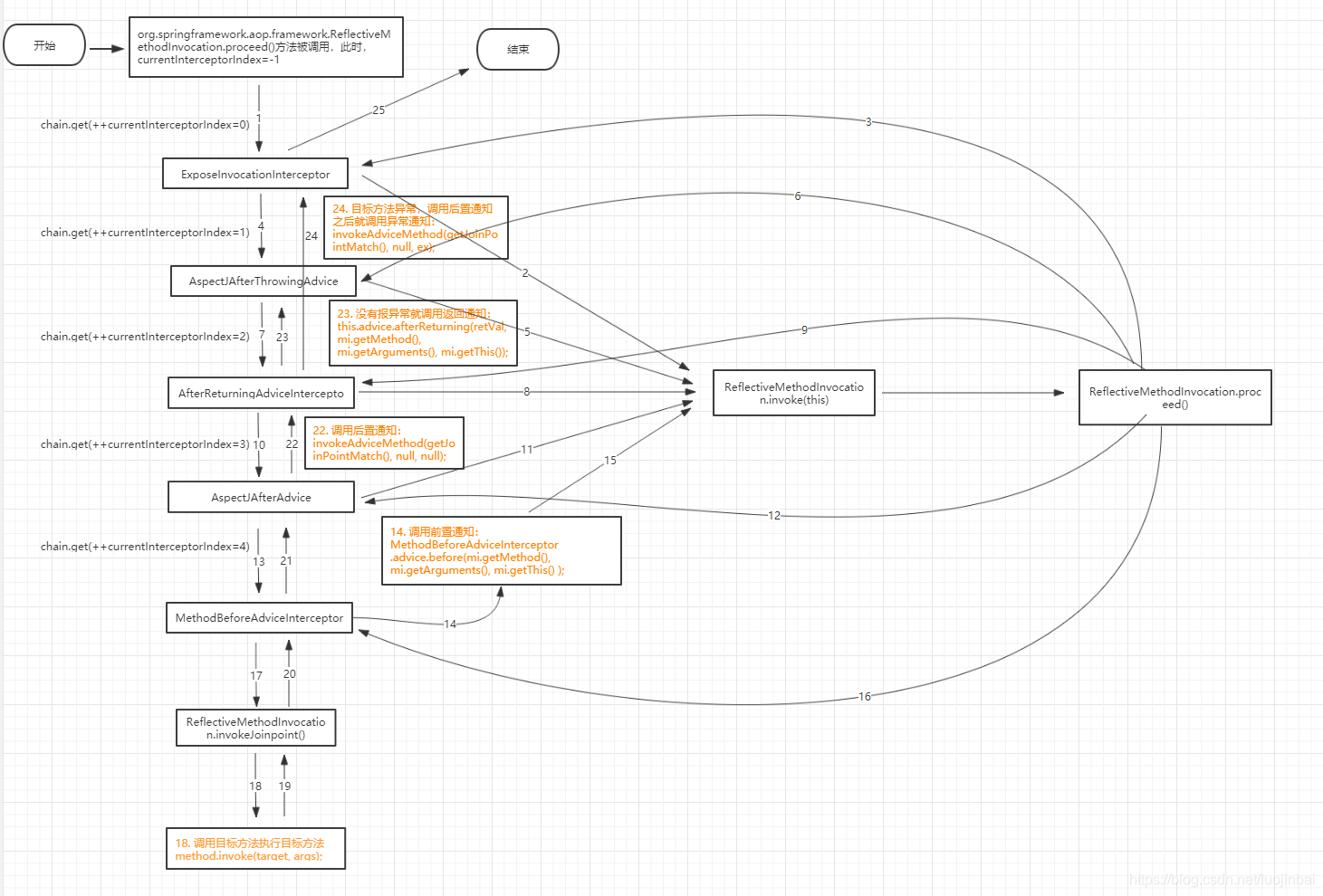目录
1. 说明
在IOC容器中获取目标组件的时候,实际获取到的是增强后的代理组件,执行目标方法的时候,也是由此代理组件去执行;
public static void main(String[] args) throws Exception {
AnnotationConfigApplicationContext applicationContext = new AnnotationConfigApplicationContext(MainConfigForAop.class);
//获取到的是增强后的代理组件
Calculator calculator = applicationContext.getBean(Calculator.class);
//代理组件执行目标方法
System.out.println("结果: " + calculator.div(10, 0));
applicationContext.close();
}2. 目标方法执行
2.1 代理组件执行目标方法流程
代理组件中保存了目标组件的详细信息,包括目标类的增强器列表,执行流程如下;
- 根据ProxyFactory对象获取将增强器转成要执行的目标方法拦截器链;
- 如果没有拦截器链,直接执行目标方法;
- 如果有拦截器链,把需要执行的目标对象,目标方法,拦截器链等信息传入创建一个 CglibMethodInvocation 对象,
并调用 Object retVal = mi.proceed(); - 执行拦截器链;
2.2 增强器转成目标方法的拦截器链
执行目标方法,进入org.springframework.aop.framework.CglibAopProxy.DynamicAdvisedInterceptor.intercept(Object, Method, Object[], MethodProxy)中:
@Override
public Object intercept(Object proxy, Method method, Object[] args, MethodProxy methodProxy) throws Throwable {
Object oldProxy = null;
boolean setProxyContext = false;
Class<?> targetClass = null;
Object target = null;
try {
if (this.advised.exposeProxy) {
// Make invocation available if necessary.
oldProxy = AopContext.setCurrentProxy(proxy);
setProxyContext = true;
}
// May be null. Get as late as possible to minimize the time we
// "own" the target, in case it comes from a pool...
target = getTarget();
if (target != null) {
targetClass = target.getClass();
}
//将增强器转成目标方法的拦截器链
List<Object> chain = this.advised.getInterceptorsAndDynamicInterceptionAdvice(method, targetClass);
Object retVal;
// Check whether we only have one InvokerInterceptor: that is,
// no real advice, but just reflective invocation of the target.
if (chain.isEmpty() && Modifier.isPublic(method.getModifiers())) {
// We can skip creating a MethodInvocation: just invoke the target directly.
// Note that the final invoker must be an InvokerInterceptor, so we know
// it does nothing but a reflective operation on the target, and no hot
// swapping or fancy proxying.
Object[] argsToUse = AopProxyUtils.adaptArgumentsIfNecessary(method, args);
retVal = methodProxy.invoke(target, argsToUse);
}
else {
// We need to create a method invocation...
// 创建CglibMethodInvocation,执行目标方法和拦截器链
retVal = new CglibMethodInvocation(proxy, target, method, args, targetClass, chain, methodProxy).proceed();
}
retVal = processReturnType(proxy, target, method, retVal);
return retVal;
}
finally {
if (target != null) {
releaseTarget(target);
}
if (setProxyContext) {
// Restore old proxy.
AopContext.setCurrentProxy(oldProxy);
}
}
}在转成拦截器链的过程中,如果是MethodInterceptor,直接加入到集合中,如果不是,使用AdvisorAdapter将增强器转为MethodInterceptor;
@Override
public MethodInterceptor[] getInterceptors(Advisor advisor) throws UnknownAdviceTypeException {
List<MethodInterceptor> interceptors = new ArrayList<MethodInterceptor>(3);
Advice advice = advisor.getAdvice();
// 如果是MethodInterceptor,则直接加入集合
if (advice instanceof MethodInterceptor) {
interceptors.add((MethodInterceptor) advice);
}
//如果不是,使用AdvisorAdapter将增强器转为MethodInterceptor;
for (AdvisorAdapter adapter : this.adapters) {
if (adapter.supportsAdvice(advice)) {
interceptors.add(adapter.getInterceptor(advisor));
}
}
if (interceptors.isEmpty()) {
throw new UnknownAdviceTypeException(advisor.getAdvice());
}
return interceptors.toArray(new MethodInterceptor[interceptors.size()]);
}得到的拦截器链集合的结果如下:
一个默认的ExposeInvocationInterceptor 和 4个增强器;
2.3 拦截器链和目标方法的执行
具体执行方法在org.springframework.aop.framework.ReflectiveMethodInvocation.proceed(),代码如下:
@Override
public Object proceed() throws Throwable {
// We start with an index of -1 and increment early.
// 初始索引=-1
if (this.currentInterceptorIndex == this.interceptorsAndDynamicMethodMatchers.size() - 1) {
// 当interceptorsAndDynamicMethodMatchers为空或者 currentInterceptorIndex=interceptorsAndDynamicMethodMatchers.size()-1的时候,
// 直接调用目标方法, invokeJoinpoint()里面实际是执行 method.invoke(target, args);
return invokeJoinpoint();
}
// 获取索引位的拦截器
Object interceptorOrInterceptionAdvice =
this.interceptorsAndDynamicMethodMatchers.get(++this.currentInterceptorIndex);
if (interceptorOrInterceptionAdvice instanceof InterceptorAndDynamicMethodMatcher) {
// Evaluate dynamic method matcher here: static part will already have
// been evaluated and found to match.
InterceptorAndDynamicMethodMatcher dm =
(InterceptorAndDynamicMethodMatcher) interceptorOrInterceptionAdvice;
if (dm.methodMatcher.matches(this.method, this.targetClass, this.arguments)) {
return dm.interceptor.invoke(this);
}
else {
// Dynamic matching failed.
// Skip this interceptor and invoke the next in the chain.
return proceed();
}
}
else {
// It's an interceptor, so we just invoke it: The pointcut will have
// been evaluated statically before this object was constructed.
// 调用拦截器的invoke方法;各个拦截器里面的执行其实是 调用自定义代码逻辑和还是调用该方法proceed();
return ((MethodInterceptor) interceptorOrInterceptionAdvice).invoke(this);
}
}拦截器和目标方法的执行流程如下图:
3. 总结
目标方法执行流程如下:
- 代理对象执行目标方法;
- CglibAopProxy.intercept();
- 得到目标方法的拦截器链(增强器包装成拦截器MethodInterceptor);
- 利用拦截器的链式机制,依次进入每一个拦截器进行执行;
- 效果:
- 正常执行:前置通知-》目标方法-》后置通知-》返回通知;
- 出现异常:前置通知-》目标方法-》后置通知-》异常通知
- 执行结束;

